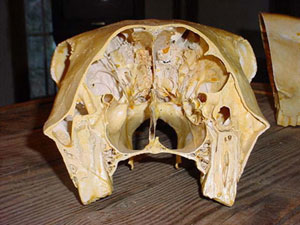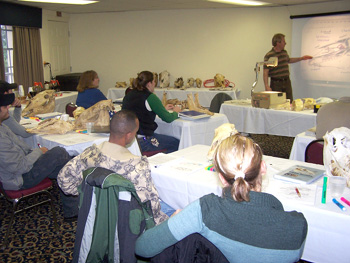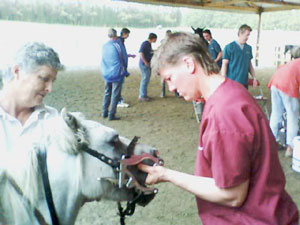INTRODUCTION TO EQUINE DENTISTRY - PROGRAM DESCRIPTION
 |
| Skull showing depth of molars. |
The Introduction to Equine Dentistry course is a four-week intensive learning experience that prepares a
student for entry into a full or part time career as an equine dental technician, or will add to a veterinarian's
training to become very proficient in equine dentistry.
This program is designed to provide the student an opportunity to acquire the knowledge needed to pass
an Equine Dental Technician Certification Written Exam (see the IAED,
EDPA and BEVA web sites) and establish a solid foundation for their needed Practical Skills. The 4-week Introductory course is rated as 260 hours with classroom, hands-on and pre-class assignments.
 |
| Students in the classroom |
Students learn basic dental procedures including:
- Floating
- Creating bit seats
- Incisor reduction and realignment
- Wave and hook correction
- Wolf teeth removal
- Canine teeth reduction
- Non-surgical extraction techniques
- Cap removal
- Full-mouth complete balancing
Introductory course also includes the use of motorized equipment, primarily rotary Dremel burrs and discs. Although
students will learn how to use motorized equipment, Dr Hyde emphasizes learning the use of hand tools on both sedated
and unsedated horses.
Students use the dentistry tools at the school during the course at no extra cost. Upon completing the course,
students will have to purchase their own dentistry tools to start their business.
Students are welcome from all countries. English is the primary language for instruction, but instruction
is available in Spanish for some classes. (See Spanish
site!) No prior veterinary school or training is required. Horsemen and women
from various horse-related backgrounds can be accepted if they demonstrate a sincere and serious desire to become
an Equine Dental Technician. However, Veterinarians and Veterinary Technicians receive priority placement.
The program is modified to meet the needs of the veterinarians, veterinary students, veterinary technicians,
and already practicing equine dental technicians that would like to attend. Acceptance to the American School of
Equine Dentistry is conditional upon the approval of Dr. Hyde.
Laws governing the performance of equine dental procedures vary from state to state, and also amongst
countries. Please investigate the laws in your area as they may pertain to you.
 |
| Students working in New Zealand. |
The cost of the program can be reduced for technicians and veterinarians already practicing and for enrolled
veterinary students.
Upon completion of the course, an apprenticeship program with an IAED,
EDPA and BEV certified equine dental technician or veterinarian is highly recommended. Placement of
the apprentice with a mentor can be arranged by the school, and extended enrollment programs are available for
advanced study and more hands-on experience.
SYLLABUS FOR THE COURSE: INTRODUCTION TO EQUINE DENTISTRY
- Studies in general equine dentistry
- Anatomy of the equine head
- Dental anatomy
- Dental development and eruption
- Aging the horse
- Mastication processes
- Performing a dental exam
- Purposes of equine dentistry
- Identifying dental problems
- Dental equipment (use of, maintenance and ordering)
- The equine alimentary system
- Performance of equine dentistry (Bit Seats, Floating, Wolf Teeth, Incisors)
- The use of dental charts
- Equine physiology
- Circulatory anatomy and homeostasis
- Immunology
- Wave formation (correcting waves, hooks, shears, steps, ETRs)
- TMJ problems
- Non-dental causes of poor mastication and weight loss
- Molar shearing (cutting)
- Identifying and removing caps
- Contagious diseases (sanitation and disinfectants)
- Proper use of motorized equipment
- Bits and bridles
- Establishing and growing your dental maintenance practice
- Business issues
- Understanding sedation and anesthesia
- Restraint techniques
- Tooth extraction techniques
- Equine nutrition and feeds
- Nutritional disorders
- Certification programs - IAED, BEVA (England), EDPA, and IGFP (Germany)
- Maintaining whole-horse balance (oral and general)
- Psychology of the horse
- Bacteriology, virology and mycology basics (preventing the spread of contagious diseases)
- Working with humane investigators and organizations
- A holistic approach to equine dentistry
- Professional ethics and practices
- Geriatric equine dentistry
Besides the topics listed above, the course "Introduction to Equine Dentistry" also includes three
weeks of intensive practical field work.
|


